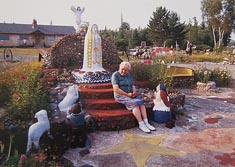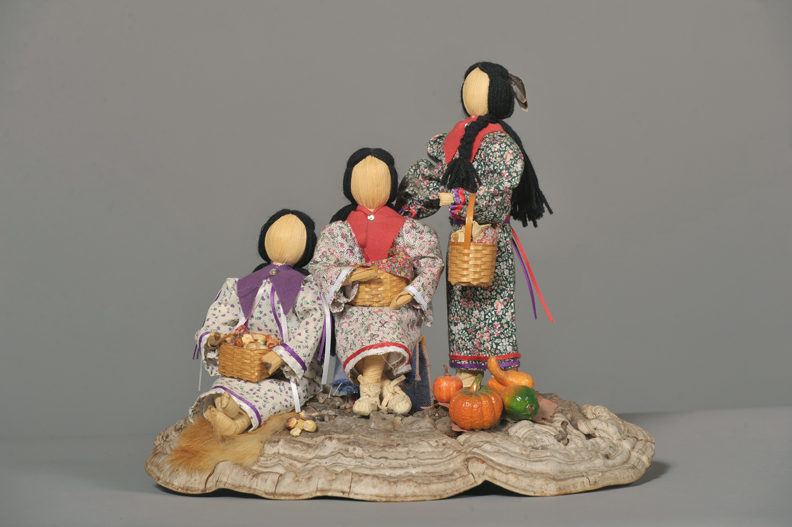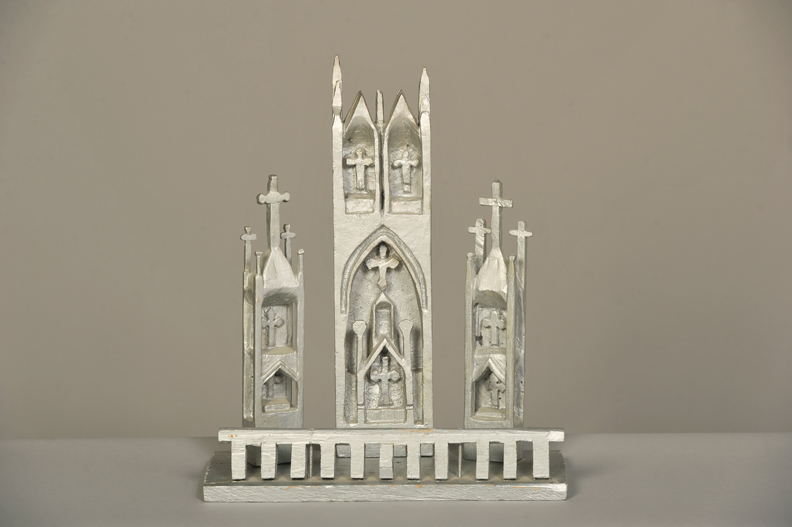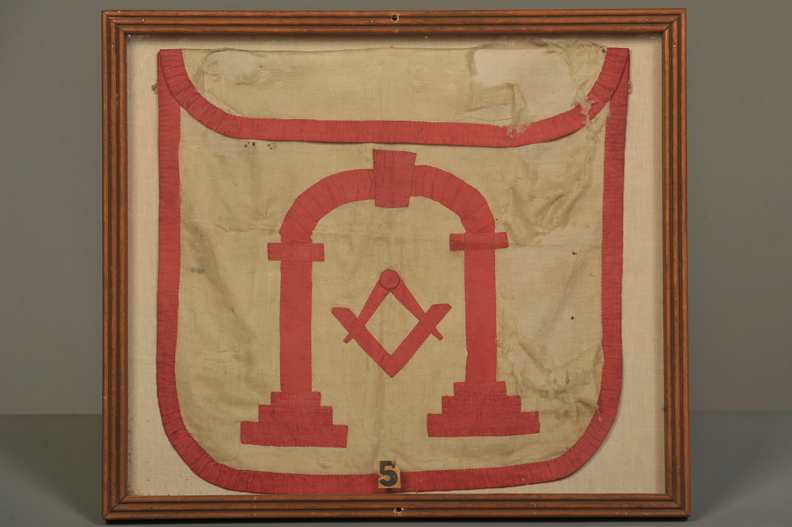Spirituality:
Sustaining the Spirit
 Some
artists place great value on objects that are used as integral parts
of religious ritual or that hold special spiritual meaning for the
audience.
Some
artists place great value on objects that are used as integral parts
of religious ritual or that hold special spiritual meaning for the
audience.
While spirituality is usually associated with religious faith, it also can be patriotic, political, collegial, or fraternal. In creating these objects, the artists choose forms and images that are clearly associated with particular traditions that evoke passionate feelings.
Case Study
Veronica Terrillion
Over more than 50 years, Veronica Terrillion (1908-2003) created a total environment of sculpture on her three-acre homestead in the Lewis County hamlet of Indian River. When she bought the land in 1952, her first project was to construct a log house. Next she dredged a pond and eventually added two islands.
Since then, travelers of Route 812 have been fascinated by her yard and garden, filled with large concrete sculptures she created herself. She made her first sculptural assemblage in 1954, a statue of Our Lady of Fatima with three children, and placed it by the road in front of her house. In succeeding years, Terrillion made scores of figures that represented her interest in her family, nature, and most passionately, her Roman Catholic faith.
Over time, she created a larger-than-life sized figure of Jesus with a bleeding heart on one of her islands, a Nativity scene, a bird tree with St. Francis of Assisi at its feet, and more. Terrillion attributed her accomplishments as an artist to her faith and her "God-given abilities."
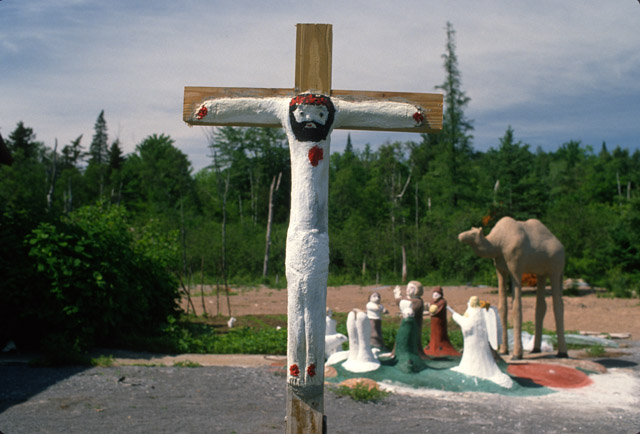
This photograph shows some of the religious figures Veronica Terrillion created in her three-acre yard and garden of concrete sculptures. The crucifix was mounted at the end of a large, trimmed cedar hedge in the shape of a cross. A nativity scene is in the background.
My House and Yard, ca. 1985
Courtesy of private collection
My Favorite Saints, ca. 1985
Courtesy of private collection
The Last Supper, ca. 1990
Courtesy of Varick & Judy Chittenden
Sustainers of Life
Pam Brown & Gail General, Akwesasne, 2011
Courtesy of the artists
The Three Sisters--corn, beans, and squash--are widely acknowledged as basic to the culinary, cultural, and spiritual life of Native Americans throughout North America. Such a combination is known in modern agriculture as companion planting. Itís also an important part of the circle of life in the traditional beliefs of the longhouse. According to the Iroquois, the Three Sisters hold a spiritual, ceremonial, and celebratory place in the garden. This piece is a "dollscape," one of several created by the artists using faceless cornhusk dolls to illustrate scenes of traditional Mohawk life.
Home Altar
John Wood, Essex County, ca. 1930
Courtesy of Varick & Judy Chittenden
Little is known about the history of this particular piece except that it is signed by John Wood and dated in pencil on the underside, and that it was acquired by a folk art collector in the Champlain Valley from a local home near Essex. From the Gothic period on, both in Europe and elsewhere, altarpieces in churches and cathedrals were often in triptych. This rather crudely carved piece adheres to the triptych form, with Gothic arches, niches, towers, and numerous crosses. The artist used aluminum radiator paint to simulate the appearance of a silver finish.
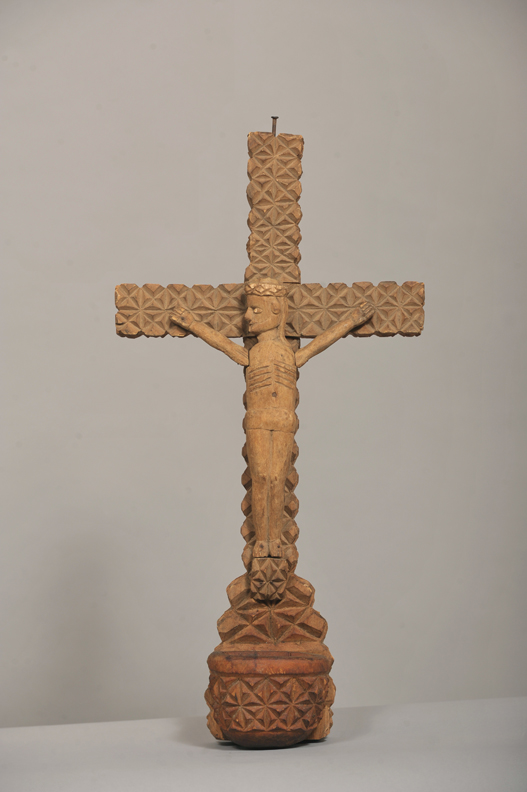 Chip-Carved Crucifix
Chip-Carved Crucifix
Unidentified Artist, Malone area, date unknown
Courtesy of Mrs. Richard Bourcier
Chip carving is a style of wood carving in which knives or chisels are used to remove small chips of the material from a flat surface in a single piece. It is usually characterized by small incisions and simple geometric patterns. As his sources told him, this elaborately carved crucifix was attributed by the late antiques dealer and collector Richard Bourcier to a woodsman working in a lumber camp in the general Malone area, probably before 1930. The carving on the cross is also reminiscent of tramp art from that same period. The artistís origins may have been French Canadian or European, as Adirondack woodsmen came from various places to work.
Beadwork Collection Baskets
Unidentified Artists, Akwesasne, ca. 1900-1905
Courtesy of St. Regis Mission Church
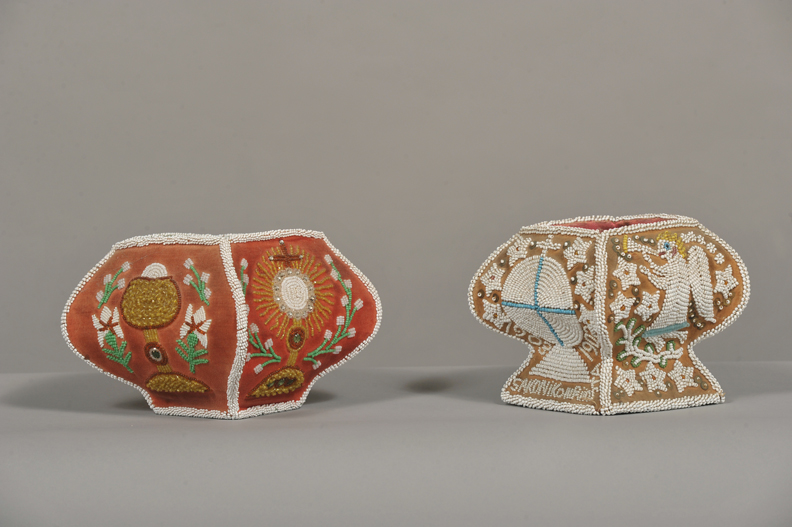 These two small baskets made in the very early 20th century are evidence of European influences on the Mohawks at Akwesasne. They were created for St. Regis Mission Church, St. Regis, Quebec, which was founded by Jesuit priests in the mid-18th century to convert Indians to Christianity. Using traditional beadworking techniques, the artists made these baskets with several Christian symbols, including crosses, a chalice, and white doves. They are made in much the same way as beadwork pieces of that time for the souvenir trade at Niagara Falls, Lake George, and Saratoga Springs.
These two small baskets made in the very early 20th century are evidence of European influences on the Mohawks at Akwesasne. They were created for St. Regis Mission Church, St. Regis, Quebec, which was founded by Jesuit priests in the mid-18th century to convert Indians to Christianity. Using traditional beadworking techniques, the artists made these baskets with several Christian symbols, including crosses, a chalice, and white doves. They are made in much the same way as beadwork pieces of that time for the souvenir trade at Niagara Falls, Lake George, and Saratoga Springs.
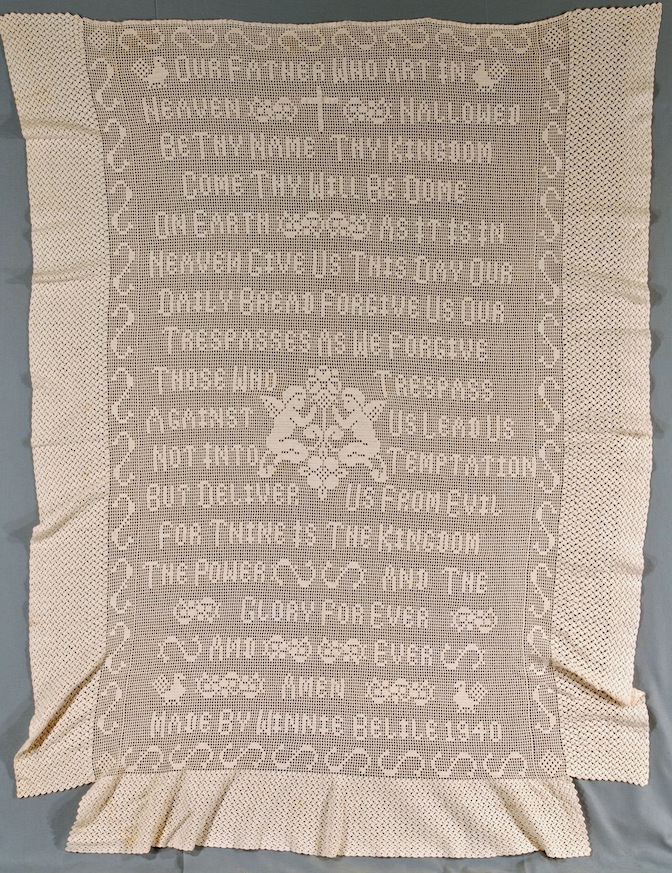 The Lord's Prayer Crocheted Bedspread
The Lord's Prayer Crocheted Bedspread
Winnie Belile, Philadelphia, 1940
Courtesy of Adirondack Museum
Unlike Roman Catholics, who traditionally decorate their churches and homes with symbols and motifs that reflect their beliefs, Protestants, who from the days of the Reformation were discouraged from surrounding themselves with iconography, often use Old and New Testament scripture instead. Among the most valued texts is the Lord's Prayer. Winnie Belile chose to create this elaborate crocheted version of the prayer in a bedspread, first tracing the letters on large sheets of paper fastened to a wall. She concluded the prayer with the common Protestant ending, "For thine is the kingdom, the power, and the glory, for ever and ever. Amen."
Masonic Aprons
The Free and Accepted Masons is an international fraternal organization that arose from obscure origins in the late 16th to early 17th century. It is a private group, with some secret rites and signs. For ceremonies, members often wear aprons, personalized and made of various materials, bearing the symbols of the group. Perhaps the most famous of early Masons in America was George Washington, whose portraits sometimes show him wearing his apron. These two aprons were worn by very early inhabitants of Canton--Stillman Foote and Lucius Tuttle. Stillman Foote's apron, of either calfskin or lambskin, was probably made in his native Vermont. Both aprons include popular motifs associated with Freemasonry.
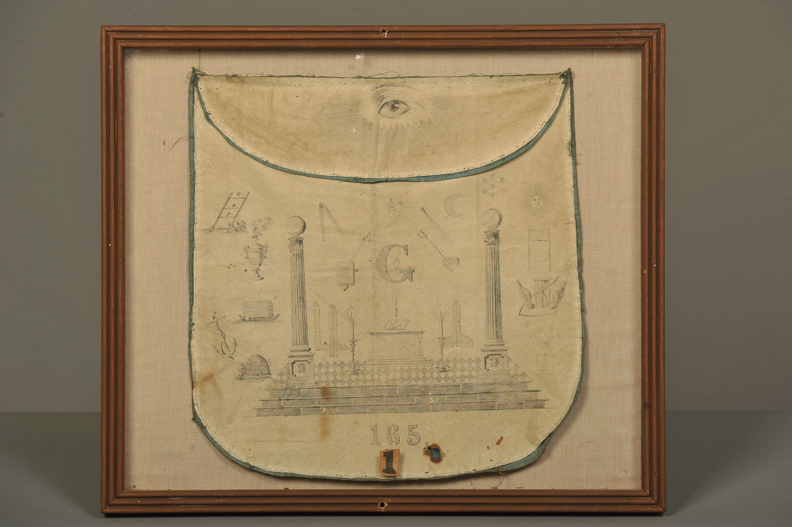 Stillman Foote Masonic Apron
Stillman Foote Masonic Apron
Unidentified Artist, Vermont or Canton, ca. 1800-1815
Courtesy of Canton Masonic Lodge
Lucius Tuttle Masonic Apron
Unidentified Artist, Canton, date unknown
Courtesy of Canton Masonic Lodge
American Eagle
Edward Goodrow, Watertown, ca. 1950s
Courtesy of Dr. George & Helen Sturtz
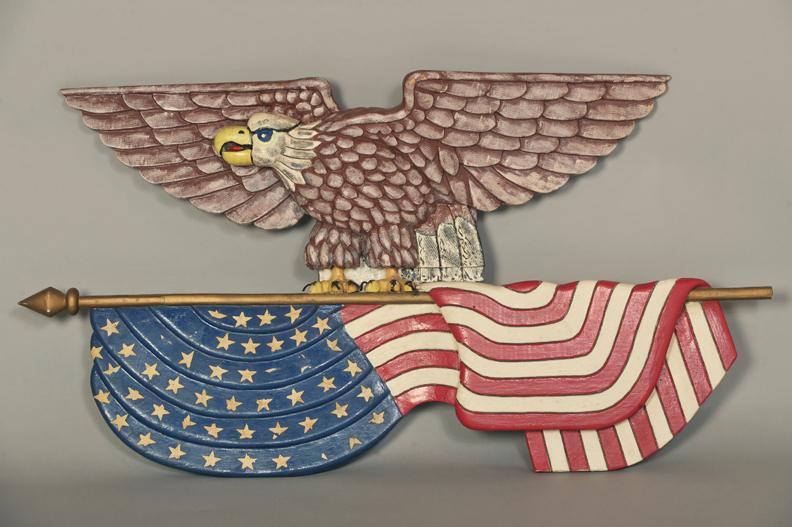 From the earliest days of our struggles to become a democracy, Americans have adopted various symbols of their patriotic spirit. Before the Revolution, there were the Liberty Pole and Liberty Cap. Since, there have been the Liberty Bell, the Statue of Liberty, Uncle Sam and, of course, the flag and the eagle. This carving by World War I veteran Edward Goodrow of Watertown was one of several large-scale carvings he made, including a Purple Heart and the Statue of Liberty with Independence Hall. Some were gifts to the VFW Post in Watertown, where they are still on display.
From the earliest days of our struggles to become a democracy, Americans have adopted various symbols of their patriotic spirit. Before the Revolution, there were the Liberty Pole and Liberty Cap. Since, there have been the Liberty Bell, the Statue of Liberty, Uncle Sam and, of course, the flag and the eagle. This carving by World War I veteran Edward Goodrow of Watertown was one of several large-scale carvings he made, including a Purple Heart and the Statue of Liberty with Independence Hall. Some were gifts to the VFW Post in Watertown, where they are still on display.
Scrimshaw Whales' Teeth
Scrimshaw is bone or ivory objects, such as whales' teeth and walrus tusks, with fanciful designs, traditionally made by sailors as a leisure-time activity. They incised the ivory with jackknives or sail needles and emphasized the incisions with black pigments like lampblack. Among the traditional subjects are whaling scenes, ships, and naval battles. The craft reached its peak in popularity from 1830 to 1850. These two teeth are good examples of scrimshaw with local imagery. While first practiced in the 17th century, these two were likely made by a merchant seaman who may have fought in the War of 1812.
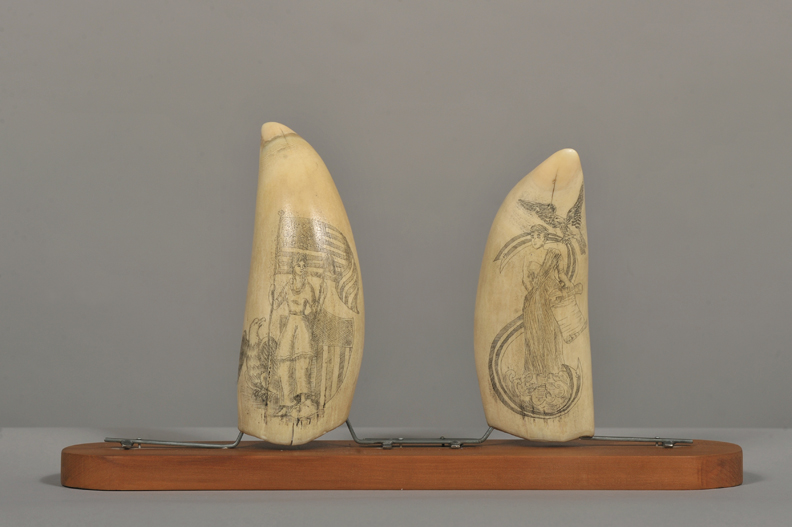 Macdonough's Victory
Macdonough's Victory
Unidentified Artist, date unknown
Courtesy of Philip J. Gordon
Battle of Lake Champlain
Attributed to S. White, date unknown
Courtesy of Philip J. Gordon
Missal Box
Alphonse LeBlanc, Tupper Lake, date unknown
Courtesy of Madeleine Gray
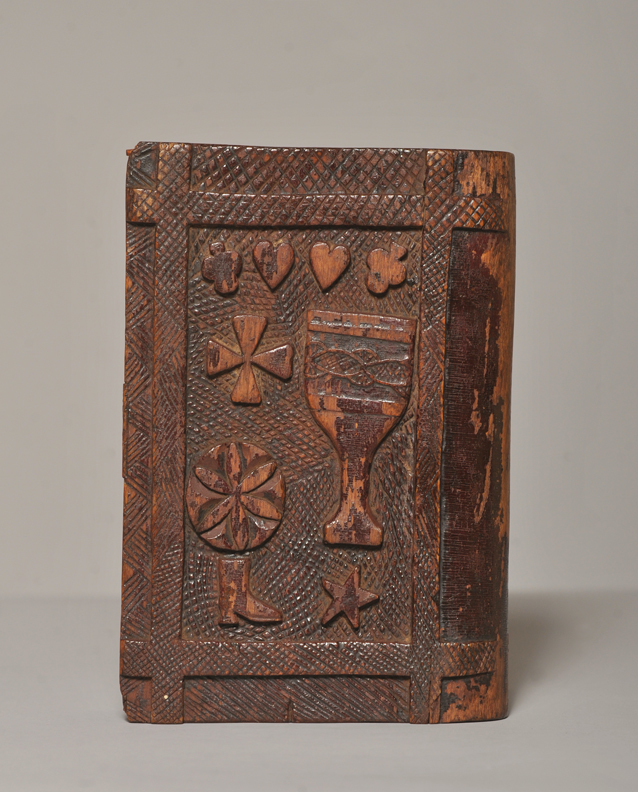
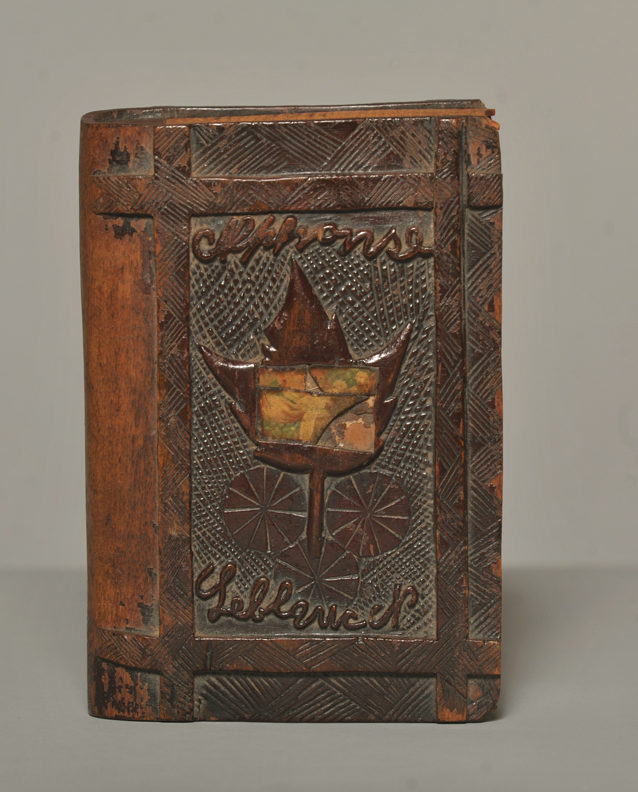 For Roman Catholics, a missal is a book of devotions containing prayers, benedictions, invocations, readings, and instructions used in the ritual of the Mass. This small wooden box, which looks like a book, is likely meant to carry a missal to and from church. The simple raised figures of hearts, a star, and a chalice are common Catholic motifs; on the reverse is a maple leaf, implying a Canadian identity as well. The name Alphonse LeBlanc, known to be from Tupper Lake, is carved on the cover; he may be either the maker, the owner, or both.
For Roman Catholics, a missal is a book of devotions containing prayers, benedictions, invocations, readings, and instructions used in the ritual of the Mass. This small wooden box, which looks like a book, is likely meant to carry a missal to and from church. The simple raised figures of hearts, a star, and a chalice are common Catholic motifs; on the reverse is a maple leaf, implying a Canadian identity as well. The name Alphonse LeBlanc, known to be from Tupper Lake, is carved on the cover; he may be either the maker, the owner, or both.








